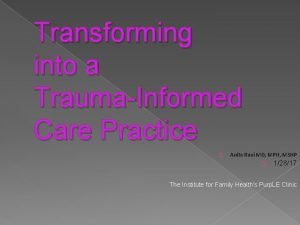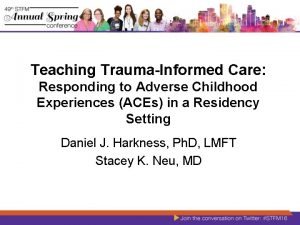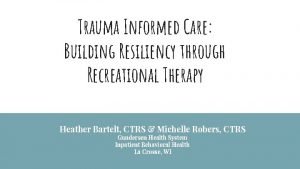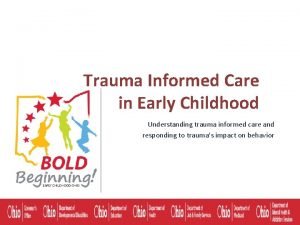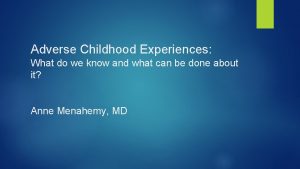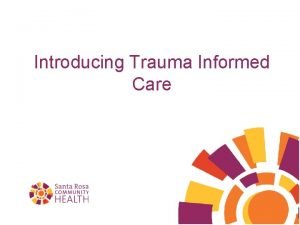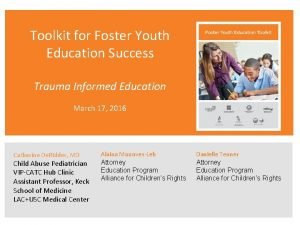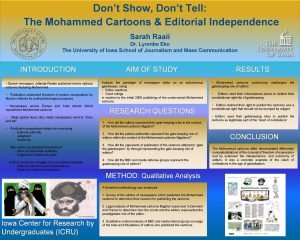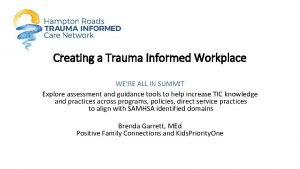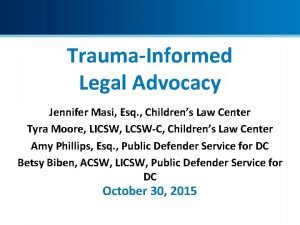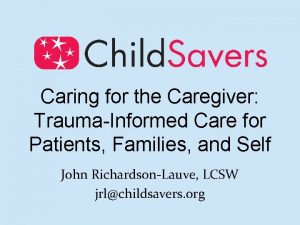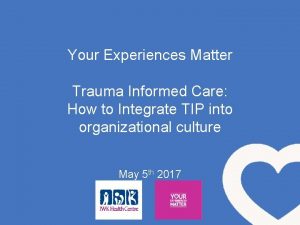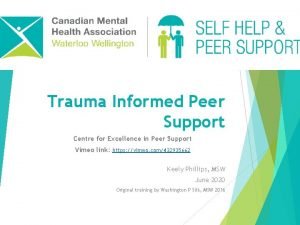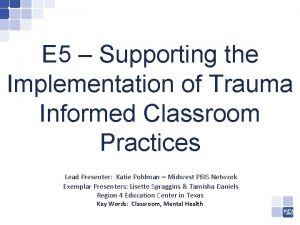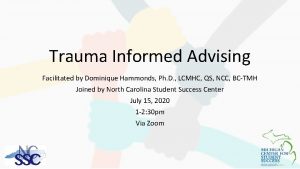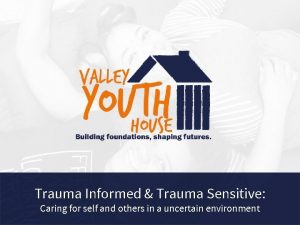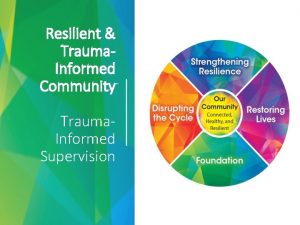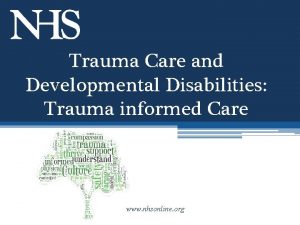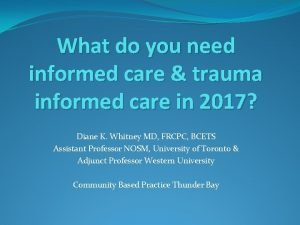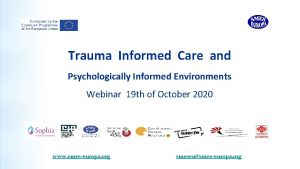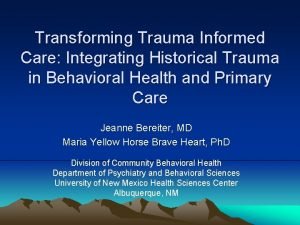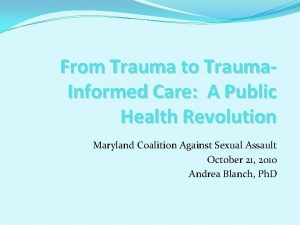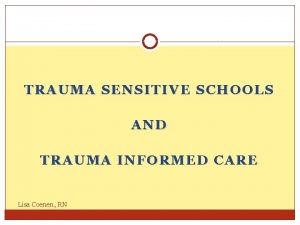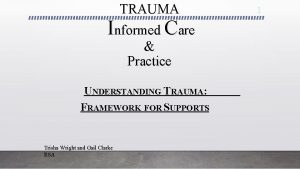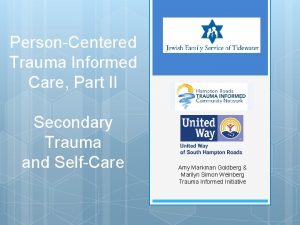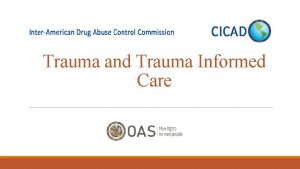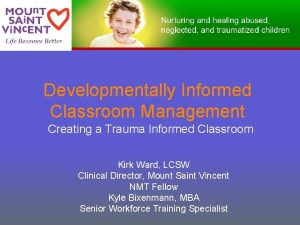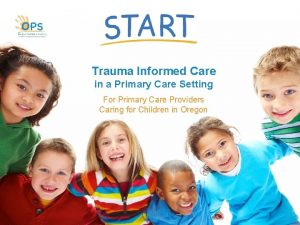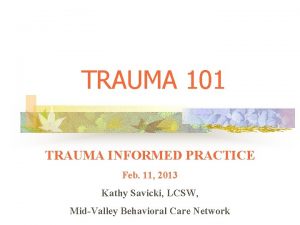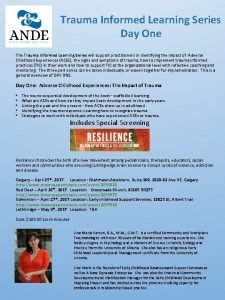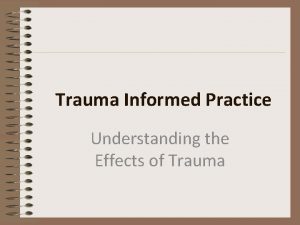Trauma Informed Care Caring in ways that dont























- Slides: 23

Trauma Informed Care Caring in ways that don’t hurt…

Disclaimer • The information provided in this presentation is designed for educational purposes only • Completion of this presentation does not prepare the viewer to work with victims of human trafficking without further training • In the event that human trafficking is suspected, contact the National Hotline at 888 -3737 -888 (c) 2015 LACAT 2

Definition • Trauma informed care (TIC) is a strengthsbased framework that is grounded in an understanding of and responsiveness to the impact of trauma, that emphasizes physical, psychological, and emotional safety for both providers and survivors, and that creates opportunities for survivors to rebuild a sense of control and empowerment (consensus-based definition from Shelter for the Storm: Trauma Informed Care in Homelessness Services Settings. 2010) (c) 2015 LACAT 3

TIC is not a tagline; it’s a lifestyle • Trauma informed care is an approach to engaging people with histories of trauma that recognizes the presence of trauma symptoms AND acknowledges the role that trauma has played in their lives • Trauma is not a supporting cast member…it quickly becomes the mega-star of the show (c) 2015 LACAT 4

Understanding trauma • Distress changes the cells of the nervous system, making it more excitable with less and less stimuli • Easily triggered and more difficult to calm down • When faced with chronic and unavoidable trauma, we shut down and learning stops; we are no longer able to understand our options • People start organizing their lives around the trauma and the reliving of the trauma – they build up layers of protection and hardened defenses which become integrated as modes of functioning and information processing (c) 2015 LACAT 5

TIC understands • Mind and body respond to traumatic events and triggers • Symptoms are adaptive rather than pathological • Empowerment, respect, choice • Survivors need to be informed and connected • Increase in awareness from staff • Use what we know about trauma and its impact in order to do our work differently and avoid causing additional harm to those we serve (c) 2015 LACAT 6

The main question Trauma informed care asks “What happened to you? ” Versus “What’s wrong with you? ” (c) 2015 LACAT 7

Symptoms of trauma • Substance abuse • Eating disorders • Self-mutilation • Suicidal ideation • Depression • Anxiety • Aggression (c) 2015 LACAT 8

Physical changes • Trauma affects the physical development of the brain in various ways • It is important to remind yourself when working with highly traumatized people that they are not processing information in the same manner that you process information • What appears to be apathy or manipulation may the be result of physical alterations because of trauma (c) 2015 LACAT 9

Physical changing due to neglect (c) 2015 LACAT 10

Physical changes due to abuse (c) 2015 LACAT 11

Physical changes due to PTSD (c) 2015 LACAT 12

Depersonalizing behaviors • Trauma survivors have adopted a set of survival skills that have helped them manage their trauma in the past • These strategies make sense given what people have experienced, even if they are confusing to others or are seen as getting in the way of current goals • These responses can be very challenging for service providers to understand in the present • Youth behaviors are less about intentionality and more about adaptive, coping and survival skills that have been learned and reinforced (c) 2015 LACAT 13

Common interpretation of behaviors • • • Attention seeking Manipulation Willfulness Self-pity Justification of circumstances (c) 2015 LACAT 14

TIC interpretation of behaviors • Troubled youth are not pathological but instead have simply not been afforded the kind of environment needed for their strengths to emerge (c) 2015 LACAT 15

What TIC can do • Trauma informed care practices can positively impact youth development, trauma recovery and self sustainability (c) 2015 LACAT 16

Understanding relationships • Humans are designed to work as part of a complex social network and our brain is impacted by the experiences and perceptions of those experiences that we have • Animals grow and thrive by becoming bigger and stronger; humans grow and thrive by being in relationships • We gather strength by being in a group (pack) with others who care and use their natural talents to provide for the group as a whole • Just as trauma occurs within relationships, healing and growth occurs within relationships (c) 2015 LACAT 17

Safety and relationships • Relationships are the intervention • We don’t need a profound treatment strategy; we need to understand the power of relationships • Caring relationships buffer the effects of stressful events • Caring relationships lead to resolution of trauma reactions • We have to give them the opportunity to re-live the story so it can end well (c) 2015 LACAT 18

How to help people feel safe • • • Consistency Trust and respect Attending to physical needs Explain what you’re doing and why Be attuned and attentive • Hear not only what is being said but also attend to facial gestures, eye movement, tone of voice, breathing rate, etc. (c) 2015 LACAT 19

Components of TIC • • • Trauma Awareness Staff training Consultation Supervision Address vicarious trauma Emphasis on Safety • Emotional and physical • Opportunities to Rebuild Control • Emphasis on the importance of choice • Strength-based Approach • Focus on both consumers and providers • Focus on the future and utilize skill-building (c) 2015 LACAT 20

Impact on Staff • Helping youth feel safe and learn self-regulation skills is a challenge • Developing trauma informed relationships is hard work, requiring focus, energy, dedication, patience • Compassion fatigue, burnout, vicarious trauma, secondary trauma or… trauma stewardship • May bring up own unresolved trauma • Can distort and change worldview, safety, spirituality • Cynical, jaded, defensive, indecisive, angry, off-balance (c) 2015 LACAT 21

Staff impact cont. • The empathy that is common in those who do this type of work, enhances TI relationships but also makes staff more vulnerable to distress • Acknowledge that trauma impacts staff – address without shame, blame or attaching pathology • Awareness of oneself, ones needs, ones limits and resources – self-care plans (c) 2015 LACAT 22

Bottom line • Our job is not to create the life we believe our clients should be living…our job is to help them live the life they choose to live • We can help them set boundaries, create goals and dream…and then we let them decide (c) 2015 LACAT 23
 Dr anita ravi
Dr anita ravi Sensory modulation
Sensory modulation Trauma-informed care cheat sheet
Trauma-informed care cheat sheet Trauma-informed care cheat sheet
Trauma-informed care cheat sheet 4 r's trauma informed care
4 r's trauma informed care 4 r's trauma informed care
4 r's trauma informed care Trauma-informed care activities for staff
Trauma-informed care activities for staff Trauma informed care lgbtq
Trauma informed care lgbtq Libby bergman
Libby bergman Trauma informed care for foster youth
Trauma informed care for foster youth Actual caring occasion
Actual caring occasion Dont ask dont tell political cartoon
Dont ask dont tell political cartoon Dont laugh at me dont call me names
Dont laugh at me dont call me names Trauma informed practice
Trauma informed practice Trauma informed workplace
Trauma informed workplace Acessexual
Acessexual Jennifer masi
Jennifer masi Trauma-informed questions for clients
Trauma-informed questions for clients Trauma informed practice
Trauma informed practice Trauma informed peer support
Trauma informed peer support Trauma infromed
Trauma infromed Trauma informed advising
Trauma informed advising Thơ thất ngôn tứ tuyệt đường luật
Thơ thất ngôn tứ tuyệt đường luật Tôn thất thuyết là ai
Tôn thất thuyết là ai
